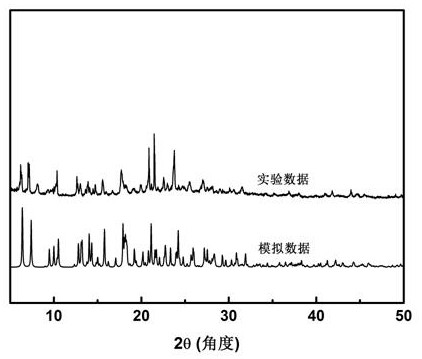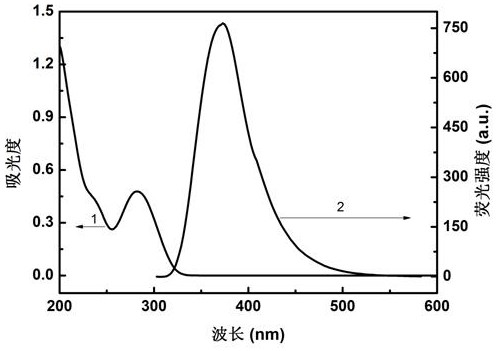Method for detecting l-cysteine based on calcium-metal organic framework material as fluorescent probe
A metal-organic framework and cysteine technology, applied in the field of highly selective detection of L-cysteine in the fluorescence "off-on" mode, can solve the problems of no related reports
- Summary
- Abstract
- Description
- Claims
- Application Information
AI Technical Summary
Problems solved by technology
Method used
Image
Examples
Embodiment 1
[0054] Preparation, Synthesis and Structural Characterization of Metal Organic Framework Complex Materials
[0055] (1) Weigh 141.6 mg Ca(NO 3 ) 2 4H 2 O and 42.1 mg (1,1':4',1"-terphenyl-3,3",5,5"-tetracarboxylic acid) organic ligand reagent were uniformly dispersed in 2 mL deionized water and 6 mL DMF Stir in medium for 0.5-1 h, then add 3-7 μL (0.33 M) of HNO 3 solution. Then the mixed solution was transferred to a stainless steel autoclave with a polytetrafluoroethylene liner, and heated at a temperature of 120-140 °C for 96-100 h. Finally, after cooling to room temperature for 48-50 h, the obtained product was washed several times with water and diethyl ether to obtain a colorless block crystal.
[0056] (2) Prepared MOF crystals, based on H 4 L 1 . The yield is 37%. C 31 h 32 Ca 1.5 N 3 o 11 Theoretical value of elemental analysis (%): C 54.54, H 4.73, N 6.15; experimental value of elemental analysis (%): C 54.79, H 4.96, N6.15; indicating that the element c...
Embodiment 2
[0066] Prepare a series of standard stock solutions for subsequent experimental testing
[0067] (1) 100 mg L -1 Preparation of metal-organic framework material suspension with a high concentration: Weigh 0.0060 g metal-organic framework material and dissolve it in 60 mL deionized water, use an ultrasonic cleaner to ultrasonically disperse for 5 minutes to form a uniform suspension, and place it in a dark place for later use.
[0068](2) Preparation of 0.1 M Tris-HCl buffer solution: Weigh 0.7880 g tris-hydrochloric acid, dissolve it in 40 mL deionized water and shake well to dissolve it completely, then add NaOH solution (0.5 M), use a pH meter to adjust the pH to 7.2, and finally make it to 50 mL with deionized water, and put it in the refrigerator for use.
[0069] (3) Preparation of 8 mM lead chloride solution: Accurately weigh 0.0178 g of lead chloride analysis reagent and dissolve it in 8 mL of deionized water, shake well to dissolve it completely, and prepare a series ...
Embodiment 3
[0072] Determination of Ultraviolet Absorption Spectrum and Fluorescence Emission Spectrum of Metal Organic Framework Materials Used in the Present Invention
[0073] Add 400 μL metal-organic framework material suspension (100 mg L -1 ), 400 μL of Tris-HCl buffer solution (pH=7.2, 0.1 M) was adjusted to 4 mL with deionized water, and the concentration of MOF in the final system solution was 10 mg L -1 . The absorbance of the system solution was detected by a UV-visible spectrophotometer; the absorbance of the system solution was measured by a fluorescence spectrophotometer at an excitation wavelength of 282 nm, an excitation slit of 5 nm, an emission slit of 5 nm, and a photomultiplier tube voltage of 560 V. Fluorescence emission spectrum. Such as image 3 As shown, 1 is the ultraviolet light absorption spectrum diagram, and 2 is the fluorescence emission spectrum diagram. From image 3 It can be seen that metal-organic framework materials have strong ultraviolet absorpti...
PUM
 Login to View More
Login to View More Abstract
Description
Claims
Application Information
 Login to View More
Login to View More - R&D
- Intellectual Property
- Life Sciences
- Materials
- Tech Scout
- Unparalleled Data Quality
- Higher Quality Content
- 60% Fewer Hallucinations
Browse by: Latest US Patents, China's latest patents, Technical Efficacy Thesaurus, Application Domain, Technology Topic, Popular Technical Reports.
© 2025 PatSnap. All rights reserved.Legal|Privacy policy|Modern Slavery Act Transparency Statement|Sitemap|About US| Contact US: help@patsnap.com



